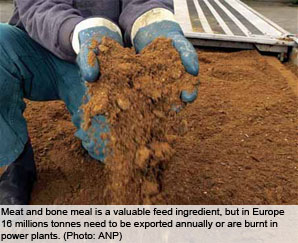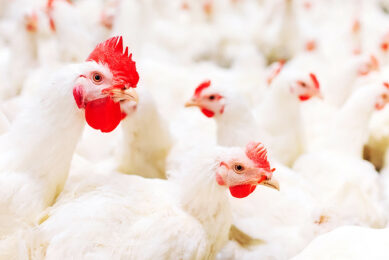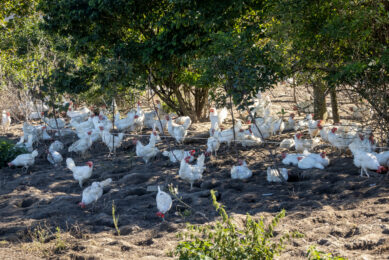Meat and bone meal – back on the menu please

For years the Dutch poultry sector has been calling for a return of meat and bone meal in animal feed. Arguments for this are strong, but political decision making is viscous and not everyone is convinced that meat and bone meal is really needed and desirable.
By Berrie Klein Swormink*
In the mid 90s Europe faced a BSE crisis. More than 200 people, mainly in the UK died of Creutzfeldt-Jacob disease. The disease occurred because people ate meat from cows that were infected with Bovine Spongiform Encephalopathy (mad cow disease), caused by a small protein called prion. Gradually more was discovered on the origin of BSE. Meat and bone meal in the feed appeared to be a part of it. This knowledge led to stringent measures on the use of meat and bone meal (MBM) in animal feed. In 1999, a ban was placed on the use of meat and bone meal in feeds for ruminants. Because this ban was difficult to maintain and it could not be ruled out that in the feed mill traces of MBM would get into ruminant feeds, the EU decided in 2000 on a total ban of its use in all animal feeds.
What is meat and bone meal?
Meat and bone meal is a product that is made from animal processing offal. Offal are those parts of the animal that are not fit for human consumption; it contains among others fat, meat, organs, bones, blood and feathers. Almost 30% of the live weight of an animal ends up as offal. A renderer – in the Netherlands this is Sonac (daughter of the Vion group) – processes the offal to meat and bone meal. Sonac sells its MBM mainly to manufacturers of pet food and to countries in Asia. Sonac has a monopoly in the Netherlands, but six Dutch poultry processors have taken up the initiative to build a new plant for rendering their slaughtering offal. The new plant – Noblesse Protein – will render about 60% of Dutch poultry offal. MBM has a high energy value, high protein content and contains many minerals and vitamins. This makes it an interesting raw material for feed manufacturers. Before 2000, also dead animals were processed into meat and bone meal. That doesn’t happen anymore. In theory, the current MBM is fit for human consumption. Cadavers today are processed into fuel for power plants.
No need for ban in poultry
The BSE crisis is over. And in the meantime it has become clear that only ruminants are susceptible to BSE-like diseases. They can be affected by these so-called prion diseases if the feed is contaminated with these protein parts. The prions can be present in MBM of ruminants with a prion disease. The fact that BSE emerged in the UK had to do with rendering of slaughterhouse offal, which took place at (too) low temperatures. Prions were not destroyed during the rendering process.
b“With today’s knowledge it can be concluded that it probably would not have been necessary to ban meat and bone meal from poultry and pig feeds,” says Goossen van den Bosch, a veterinarian in Uddel, the Netherlands. Van den Bosch still supports the drastic measures taken by the EU. “It looked as if an enormous problem for human health was emerging, while the details on the cause were not completely clear then. Fortunately, the measures taken were right and the number of cows in the EU with BSE has dropped to a few dozens per year.”
Until today there are no signs that poultry and pigs are susceptible to BSE-like diseases. Scientists therefore assume that meat and bone meal from poultry and pigs can be used in feeds without any risks.
Since the ban on the use of MBM in poultry feeds was installed, the poultry sector has often called for lifting of the ban. MBM for decades has been a valuable and cheap protein source in feed. It also contains valuable minerals and vitamins.
Strong arguments
A very strong argument to have MBM back in poultry feed is depicted by the fact that chickens by nature are omnivores; they eat everything. Living in nature, chickens combine vegetable food with all kinds of little animals such as worms and beetles. The lobby to have MBM back in animal feed is slowly progressing. The Dutch Minister of Agriculture, Gerda Verburg, is supporting the advocacy of agriculture support groups to lift the ban in Brussels, where the European decision making takes place. But this is a slow and arduous route. Not only from a nutritional stand point would it be beneficial to have MBM back in feeds, also the environment benefits from it. Recently scientist Emiel Elferink in his PhD thesis at the University of Groningen calculated that in Europe annually around 16 million tonnes of meat and bone meal is replaced by 23 million tonnes of soybeans. Feed companies compensate the lack of MBM mainly by putting more soy cake in feeds for poultry and pigs. The result of this increased demand for soybeans is visible in countries like Brazil, a main supplier of soybeans for the EU. Since the ban on MBM was installed, the area planted with soybeans has increased from 10 million hectares in the 80s to more than 20 million hectares at the beginning of this century. The ban on meat and bone meal has indirectly caused major effects on nature through deforestation of tropical rain forests.
“Do not sweep under the carpet”
Now Brussels is dawdling with lifting the ban on MBM without having scientific arguments to maintain it and it makes some poultry farmers boil with rage. One of them is broiler grower Peter Stroo in Wieringermeer in the northwest of the Netherlands. “To me it is only a matter of money. I think it is beyond sanity to sweep such a high value product under the carpet and not to use it in the feed,” argues Stroo. He estimates that the ban costs him around €15,000 per year because of higher feed costs and lower yield of the broilers. “Until 2000 slaughterhouses received more than €31 per tonne of offal. Suddenly they had to pay to get rid of the stuff.” According to Stroo, interest groups should bang the drums harder to get the MBM ban lifted.
The broiler grower says a chicken does not benefit by leaving products of animal origin out of the feed. This influences the bird’s performance. Day old chicks are more sensitive to digestion problems on a meatless diet. He also believes that behavioural problems, wet litter and foot lesions have to do with the withdrawal of MBM from the feed.
The remarks from Stroo are typical and heard from many other broiler growers. Critics say that the ban on the use of antibiotic growth promoters in feed in 2006 would have been easier to balance with meat and bone meal in the feed.
“Perfect performance – vegetable feed”
Not everybody is convinced that a whole vegetable feed by definition is worse than feed containing MBM. “A chicken can perform perfectly with feed containing only raw materials of vegetable origin,” states Sible Westendorp, poultry veterinarian in the south of the Netherlands. “It can be more difficult to manufacture the feed if only vegetable ingredients are allowed. Soybeans for example contain ANFs (antinutritional factors) that need to be neutralised during feed production.”
Westendorp’s opinion is supported by Jan Grievink, poultry specialist at feed miller Arkervaart-Twente in Nijkerk. “Since the ban on meat and bone meal was installed, knowledge about optimum composition of poultry feed has remarkably increased. Today we are very well capable of making a very good performing feed with only vegetable ingredients.” Grievink says that even if the ban on MBM is lifted it is questionable if the raw material will return in poultry feeds. “That not only is a financial calculation. Factors such as bacterial contamination risks and the question if supermarkets will accept meats produced from animals that have been fed meat and bone meal also play a role.”
Quick research results
To get more clarity on the real effect of MBM in poultry feed, the Dutch Livestock and Meat Product Board has asked Wageningen University to conduct a trial with broilers. In this research with 660 broilers and four feeds with equal nutritional values were compared: a control feed without MBM, and three feeds with respectively 10%, 17.5% and 25% of the crude protein coming from (pig) meat and bone meal. Some weeks ago the broilers were processed. “The results are not clear yet,” says Jan van Harn, researcher at Wageningen UR. The scientists not only examine growth and FCR, but also intestinal health, yield, litter quality, foot lesions, and hock dermatitis.
“Within a couple of weeks we will present the results. Then we hope to give an indication if meat and bone meal can contribute in preventing health problems, disbacteriosis, wet droppings and foot lesions,” Van Harn says.
“Whatever the trial yields, fact is that meat and bone meal is a nice and useful raw material in poultry feeds,” he adds. To get more results he would like to do an additional trial on a more practical scale. “But that won’t happen in the short term. Because of the meat and bone meal ban, the birds cannot end up in humane consumption, which makes such a trial too costly.”
Testing on cannibalism
Slowly there seems to be some movement in Brussels to relax the MBM ban. An important requirement will be that test kits need to be developed to distinguish the different types of MBM. Brussels not only wants to avoid that ruminants are fed own kind MBM, but also that this counts for pigs and poultry. Dutch interest groups say that scientific proof for the latter is lacking and state that is purely an emotional requirement. However, they admit that they have to work on it in order to get MBM back into the feeds again.
CCL Nutricontrol in Veghel, the Netherlands, is one of the parties that work on developing the required test kits. A detection method to demonstrate DNA-material from ruminants is already present. At the moment the EU has commissioned official trials in practice to confirm functioning of the testing method. “That should not be problem,” expects Rob Margry from CCL. “Thus the availability of reliable test kits does not have to be an obstacle for allowing meat and bone meal back in feeds.”
The first relaxation the EU will execute – when a reliable test becomes available – will be lifting of the ban on the use of MBM from pigs and poultry in aquafeeds. Insiders expect this not to happen before 2011. The next step will be to allow pig MBM in poultry feed and poultry MBM in pig feed. According to EU planning this will take place in 2013-2014. But interest groups find the route is taking too long and they will try to speed up the end of the ban on meat and bone meal.
*Adapted and translated from the Dutch poultry magazine “Pluimveehouderij”.
Source: FeedTech vol 14 nr 1, 2010











